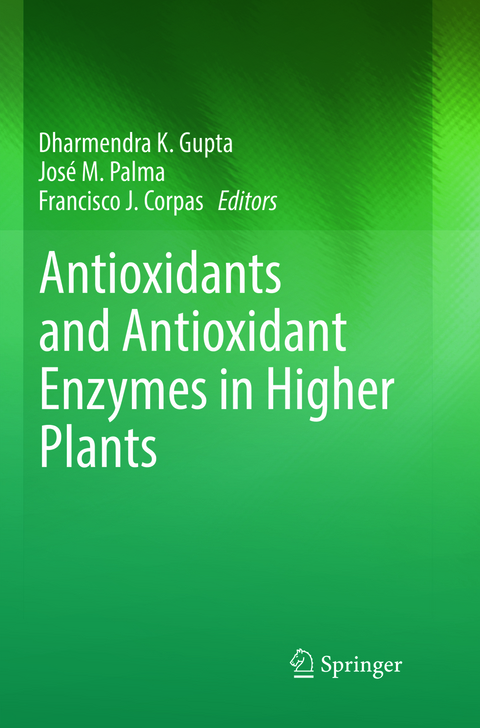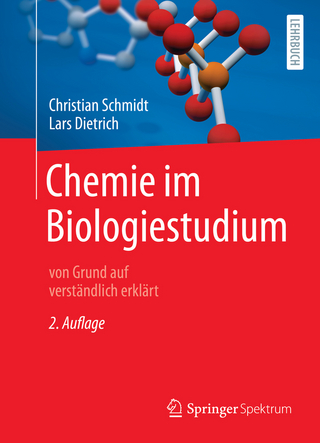
Antioxidants and Antioxidant Enzymes in Higher Plants
Springer International Publishing (Verlag)
978-3-030-09146-0 (ISBN)
Major reactive oxygen species (ROS)-scavenging/modulating enzymes include the superoxide dismutase (SOD) that dismutates O2 into H2O2, which is followed by the coordinated action of a set of enzymes including catalase (CAT), ascorbate peroxidase (APX), glutathione peroxidase (GPX) and peroxiredoxins (Prx) that remove H2O2. In addition to the ROS scavenging enzymes, a number of other enzymes are found in various subcellular compartments, which are involved in maintaining such redox homeostasis either by directly scavenging particular ROS and ROS-byproducts or by replenishing antioxidants. In that respect, these enzymes can be also considered antioxidants. Such enzymes include monodehydroascorbate reductase (MDAR), dehydroascorbate reductase (DHAR), glutathione reductase (GR), alternative oxidases (AOXs), peroxidases (PODs) and glutathione S-transferases (GSTs). Some non-enzymatic antioxidants, such as ascorbic acid (vitamin C), carotenes (provitamin A), tocopherols (vitamin E), and glutathione (GSH), work in concert with antioxidant enzymes to sustain an intracellular steady-state level of ROS that promotes plant growth, development, cell cycles and hormone signaling, and reinforces the responses to abiotic and biotic environmental stressors. Offering a unique compilation of information on antioxidants and antioxidant enzymes, this is a valuable resource for advanced students and researchers working on plant biochemistry, physiology, biotechnology, and signaling in cell organelles, and those specializing in plant enzyme technology.
Dharmendra K. Gupta is Sr. Scientist of environmental biotechnology/radioecology and already published more than 80 refereed research papers/review articles in peer reviewed journals and edited eleven books. His field of research includes abiotic stress by radionuclides/heavy metals and xenobiotics in plants; antioxidative system in plants, environmental pollution (radionuclides/heavy metals) remediation through plants (phytoremediation). José Manuel Palma is Research Professor of antioxidants and free radicals in plant system and published more than 100 peer reviewed research papers and articles, and also edited five books from different publishers including three from Springer, and several special issues of diverse international journals. At present he is involved in the investigation of the interaction between nitric oxide and antioxidants during fruit ripening. He leads the research group "Antioxidants, Free Radicals and Nitric Oxide in Biotechnology, Food and Agriculture" at the Estación Experimental del Zaidín, CSIC, Granada, Spain. He was also Deputy Director and Acting Director of such institute in the period 2007-2014. Francisco J. Corpas is a staff member of the Spanish National Research Council (CSIC) which has more than 25 years of research experience in the metabolism of antioxidants and nitric oxide (NO) in higher plants under physiological and adverse environmental conditions. At present, he is the Head of the Department of Biochemistry, Cell and Molecular Biology of Plants at Research Institute named "Estación Experimental del Zaidín"-CSIC, Granada Spain. He already published more than 150 refereed research papers/review articles in peer reviewed journals (according with Scopus database) and edited seven books.
Plant superoxide dismutases: Function under abiotic stress conditions.- Studies of catalase in plants under abiotic stress.- Ascorbate peroxidase functions in higher plants: The control of the balance between oxidative damage and signaling.- Glutathione reductase: Safeguarding plant cells against oxidant damage.- Function of the various MDAR isoforms in higher plants.- Peroxiredoxins: Types, characteristics and functions in higher plants.- Redox protein thioredoxins: Function under salinity, drought and extreme temperature conditions.- Biosynthesis and regulation of ascorbic acid in plants.- Glutathione metabolism and its function in higher plants adapting to stress.- Revisiting carotenoids and their role in plant stress responses: From biosynthesis to plant signaling mechanisms during stress. Abiotic stress response in plants - the relevance of tocopherols.- Role of flavonoids in plant stress. Class III peroxidases: isoenzymes functions, localization and redox regulation.
| Erscheinungsdatum | 05.03.2022 |
|---|---|
| Zusatzinfo | XIII, 300 p. 30 illus., 22 illus. in color. |
| Verlagsort | Cham |
| Sprache | englisch |
| Maße | 155 x 235 mm |
| Gewicht | 654 g |
| Themenwelt | Naturwissenschaften ► Biologie ► Biochemie |
| Naturwissenschaften ► Biologie ► Botanik | |
| Naturwissenschaften ► Biologie ► Zellbiologie | |
| Schlagworte | ascorbic acid • carotenoids • Catalase • flavonoids • glutathione • Oxidative Damage • Reactive oxygen species (ROS) • ROS-scavenging enzymes • Stress tolerance • superoxide dismutase |
| ISBN-10 | 3-030-09146-5 / 3030091465 |
| ISBN-13 | 978-3-030-09146-0 / 9783030091460 |
| Zustand | Neuware |
| Informationen gemäß Produktsicherheitsverordnung (GPSR) | |
| Haben Sie eine Frage zum Produkt? |
aus dem Bereich


